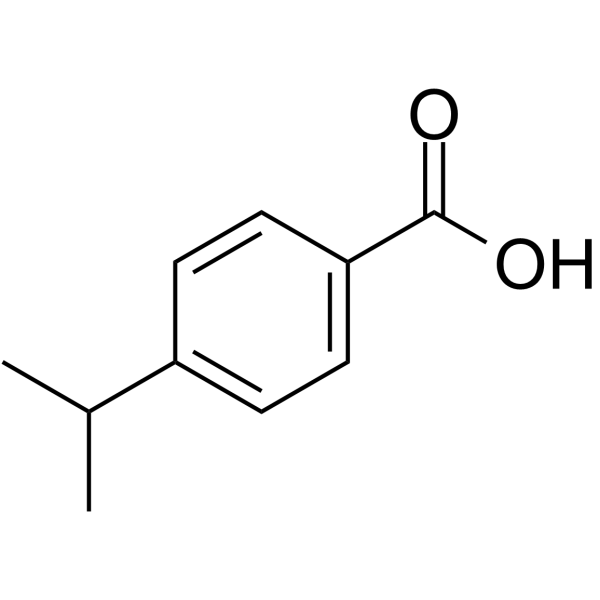Physicochemical Properties
| Molecular Formula | C10H12O2 |
| Molecular Weight | 164.20 |
| Exact Mass | 164.083 |
| CAS # | 536-66-3 |
| PubChem CID | 10820 |
| Appearance | White to off-white solid powder |
| Density | 1.1±0.1 g/cm3 |
| Boiling Point | 271.8±19.0 °C at 760 mmHg |
| Melting Point | 117-120 °C(lit.) |
| Flash Point | 128.1±16.2 °C |
| Vapour Pressure | 0.0±0.6 mmHg at 25°C |
| Index of Refraction | 1.535 |
| LogP | 3.23 |
| Hydrogen Bond Donor Count | 1 |
| Hydrogen Bond Acceptor Count | 2 |
| Rotatable Bond Count | 2 |
| Heavy Atom Count | 12 |
| Complexity | 155 |
| Defined Atom Stereocenter Count | 0 |
| InChi Key | CKMXAIVXVKGGFM-UHFFFAOYSA-N |
| InChi Code | InChI=1S/C10H12O2/c1-7(2)8-3-5-9(6-4-8)10(11)12/h3-7H,1-2H3,(H,11,12) |
| Chemical Name | 4-propan-2-ylbenzoic acid |
| HS Tariff Code | 2934.99.9001 |
| Storage |
Powder-20°C 3 years 4°C 2 years In solvent -80°C 6 months -20°C 1 month |
| Shipping Condition | Room temperature (This product is stable at ambient temperature for a few days during ordinary shipping and time spent in Customs) |
Biological Activity
| References |
[1]. Antifungal constituents of the stem bark of Bridelia retusa. Phytochemistry. 2003 Feb;62(4):637-41. [2]. Inhibition of the activity of mushroom tyrosinase by alkylbenzoic acids. Food Chemistry. 2006 Jan; 94(1): 1-6. |
| Additional Infomation |
P-cumic acid is a cumic acid that consists of benzoic acid substituted by an isopropyl group at position 4. It has a role as a plant metabolite. It is a conjugate acid of a p-cumate. 4-Isopropylbenzoic acid has been reported in Cuminum cyminum, Bridelia retusa, and other organisms with data available. See also: Copper dimethyldithiocarbamate (annotation moved to). |
Solubility Data
| Solubility (In Vitro) | DMSO : 100 mg/mL (609.01 mM) |
| Solubility (In Vivo) |
Solubility in Formulation 1: ≥ 2.5 mg/mL (15.23 mM) (saturation unknown) in 10% DMSO + 40% PEG300 + 5% Tween80 + 45% Saline (add these co-solvents sequentially from left to right, and one by one), clear solution. For example, if 1 mL of working solution is to be prepared, you can add 100 μL of 25.0 mg/mL clear DMSO stock solution to 400 μL PEG300 and mix evenly; then add 50 μL Tween-80 to the above solution and mix evenly; then add 450 μL normal saline to adjust the volume to 1 mL. Preparation of saline: Dissolve 0.9 g of sodium chloride in 100 mL ddH₂ O to obtain a clear solution. Solubility in Formulation 2: 2.5 mg/mL (15.23 mM) in 10% DMSO + 90% (20% SBE-β-CD in Saline) (add these co-solvents sequentially from left to right, and one by one), suspension solution; with ultrasonication. For example, if 1 mL of working solution is to be prepared, you can add 100 μL of 25.0 mg/mL clear DMSO stock solution to 900 μL of 20% SBE-β-CD physiological saline solution and mix evenly. Preparation of 20% SBE-β-CD in Saline (4°C,1 week): Dissolve 2 g SBE-β-CD in 10 mL saline to obtain a clear solution. Solubility in Formulation 3: ≥ 2.5 mg/mL (15.23 mM) (saturation unknown) in 10% DMSO + 90% Corn Oil (add these co-solvents sequentially from left to right, and one by one), clear solution. For example, if 1 mL of working solution is to be prepared, you can add 100 μL of 25.0 mg/mL clear DMSO stock solution to 900 μL of corn oil and mix evenly. (Please use freshly prepared in vivo formulations for optimal results.) |
| Preparing Stock Solutions | 1 mg | 5 mg | 10 mg | |
| 1 mM | 6.0901 mL | 30.4507 mL | 60.9013 mL | |
| 5 mM | 1.2180 mL | 6.0901 mL | 12.1803 mL | |
| 10 mM | 0.6090 mL | 3.0451 mL | 6.0901 mL |
